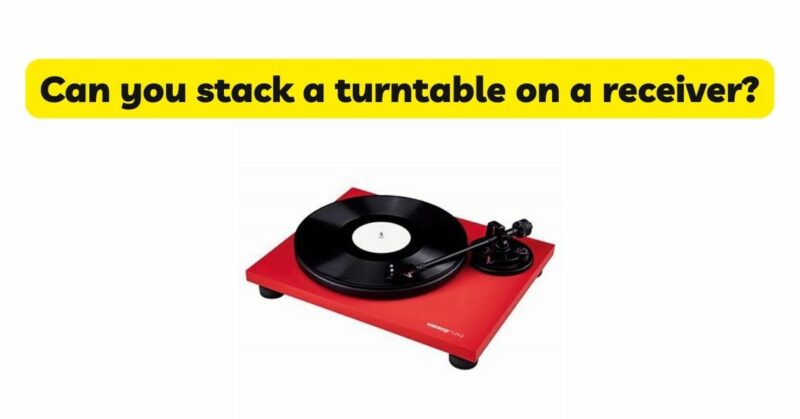When it comes to setting up a home audio system, finding the right arrangement for your equipment is essential for convenience and functionality. However, questions arise regarding the practice of stacking a turntable on top of a receiver. In this article, we will explore the potential risks and considerations associated with stacking a turntable on a receiver, as well as alternative placement options to ensure the optimal performance and longevity of your audio equipment.
Understanding the Components:
- Turntable: A turntable is a precision audio device designed to play vinyl records. It consists of various delicate components, including the platter, tonearm, cartridge, and stylus. The turntable requires careful handling and placement to prevent any disruptions to its operation or damage to its sensitive parts.
- Receiver: A receiver, also known as an audio/video receiver (AVR) or amplifier, is the central hub of an audio system. It combines an amplifier with audio and video inputs, allowing you to connect various audio sources and speakers. The receiver generates the power necessary to drive the speakers and control the audio output.
The Risks of Stacking a Turntable on a Receiver:
- Vibration and Mechanical Interference: Stacking a turntable on top of a receiver can potentially introduce vibrations and mechanical interference. Vibrations from the receiver’s internal components or external sources, such as nearby speakers, can affect the delicate components of the turntable, including the cartridge and stylus. These vibrations can lead to tracking errors, mistracking, or compromised sound quality during playback.
- Heat Build-up and Ventilation: Audio receivers generate heat during operation, and proper ventilation is crucial to maintain their optimal performance. Placing a turntable directly on top of a receiver can obstruct the airflow, leading to heat build-up and potentially affecting the receiver’s functionality and longevity. Excessive heat can cause electronic components to overheat, degrade, or fail prematurely.
- Weight and Stability: Stacking a turntable on a receiver can create an unstable arrangement, especially if the turntable is significantly larger or heavier than the receiver. The additional weight of the turntable on top of the receiver can potentially strain the receiver’s chassis, leading to structural issues or an increased risk of toppling. Stability is crucial to ensure the proper functioning and safety of the equipment.
Alternative Placement Options:
- Separate Stands or Shelves: Consider using separate stands or shelves for each component. Dedicated turntable stands or shelves designed for audio equipment provide stable surfaces and help isolate the turntable from vibrations. This arrangement ensures proper airflow and prevents heat build-up, maintaining the optimal performance and longevity of both the turntable and the receiver.
- Isolation Platforms: Isolation platforms or pads can be used between the turntable and the receiver to minimize the transfer of vibrations. These specially designed platforms or pads absorb vibrations and provide an additional layer of protection for the turntable. This arrangement helps maintain the integrity of the audio signal and reduces the risk of tracking errors or compromised sound quality.
- Side-by-Side Placement: If space permits, placing the turntable and the receiver side by side on the same surface is an alternative option. Ensure that there is sufficient space between the components to allow for proper ventilation and airflow. This arrangement allows for easy access to both devices while minimizing the risk of vibration transfer and heat-related issues.
- Dedicated Audio Racks or Furniture: Investing in dedicated audio racks or furniture provides a comprehensive solution for organizing and accommodating your audio equipment. These racks are designed to separate and support each component, offering proper ventilation, stability, and cable management. Audio racks also offer the flexibility to expand your setup in the future while maintaining a clean and organized space.
Conclusion:
While stacking a turntable on top of a receiver may seem like a convenient space-saving solution, it comes with potential risks and considerations. Vibration, mechanical interference, heat build-up, and stability issues can compromise the performance and longevity of both the turntable and the receiver. To ensure optimal audio quality and protect your equipment, consider alternative placement options such as separate stands or shelves, isolation platforms, side-by-side placement, or dedicated audio racks. These arrangements provide stability, proper ventilation, and minimize the risk of vibration transfer, allowing you to enjoy the full potential of your audio system while preserving the lifespan of your cherished vinyl records and equipment.


